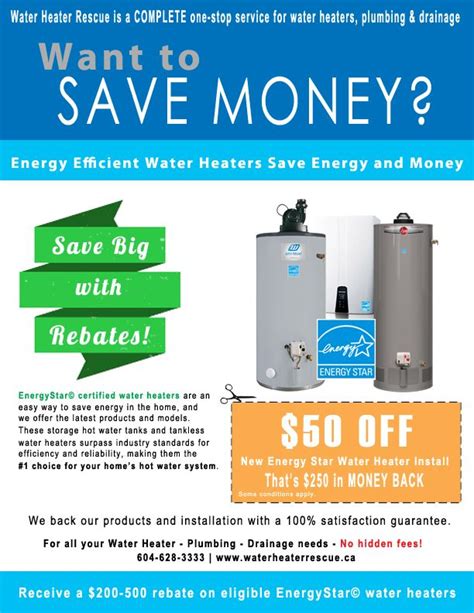Introduction
In today’s fast-paced world, conserving energy and saving money are two priorities that resonate with many households. With energy costs on the rise, it’s essential to consider options that can help mitigate these expenses while also contributing to a more sustainable future. One such option is upgrading your water heater to an ENERGY STAR® certified model. By choosing these energy-efficient appliances, not only can you reduce your monthly utility bills, but you may also qualify for various rebates that can further enhance your savings.
What is ENERGY STAR?
ENERGY STAR is a program initiated by the U.S. Environmental Protection Agency (EPA) and the Department of Energy (DOE) to promote energy efficiency. Products that earn the ENERGY STAR label meet strict energy efficiency guidelines, ensuring that consumers are purchasing appliances that consume less energy without sacrificing performance. This includes a variety of home appliances, including water heaters, which can make a significant impact on both energy consumption and household costs.
Understanding Water Heaters
Water heaters are essential for residential comfort, providing hot water for various needs such as bathing, cooking, and cleaning. However, traditional water heaters can be energy hogs, leading to high energy bills. There are generally two types of water heaters: storage and tankless. While both serve the same purpose, ENERGY STAR certified models are designed to use less energy than their conventional counterparts.
How ENERGY STAR Rebates Work
ENERGY STAR rebates are incentive programs offered at the federal, state, or local level to encourage homeowners to upgrade to energy-efficient appliances. These rebates can vary in amount but typically cover a portion of the cost of qualifying ENERGY STAR water heaters. To take advantage of these rebates, homeowners must follow specific guidelines, which often involve:
- Purchasing an ENERGY STAR certified water heater.
- Submitting a rebate application to the relevant authority.
- Providing proof of purchase, such as receipts and product specifications.
By properly navigating the rebate process, homeowners can significantly reduce their upfront investment in a new, energy-efficient water heater.
The Benefits of Switching to ENERGY STAR Water Heaters
Switching to an ENERGY STAR certified water heater offers multiple benefits:
- Energy Savings: ENERGY STAR models use advanced technologies that can reduce energy consumption by 10% to 50% compared to conventional water heaters.
- Lower Utility Bills: By consuming less energy, households can expect noticeable reductions in their monthly energy bills.
- Environmental Impact: Using less energy contributes to reduced greenhouse gas emissions, making this an environmentally friendly choice.
- Increased Home Value: An energy-efficient home is often more attractive to buyers, potentially increasing the resale value of the property.
- Quality and Reliability: ENERGY STAR appliances are built to higher standards, often resulting in longer lifespans and less frequent need for repairs.
Additional Incentives for Energy Efficiency
In addition to federal or state rebates, many utility companies offer their own incentive programs for energy-efficient upgrades. These can include cash rebates, discounts, and specialized programs tailored to help consumers transition to sustainable energy solutions. It’s beneficial for homeowners to check with local utility providers to find out what offers are available in their area.
How to Choose the Right ENERGY STAR Water Heater
When selecting an ENERGY STAR certified water heater, consider the following factors:
- Type of Water Heater: Decide between traditional tank storage and tankless options based on your household’s hot water needs.
- Size: Ensure the capacity of the water heater is appropriate for your household size. Too small can lead to running out of hot water, while too large can be wasteful.
- Energy Factor (EF): Check the EF rating, which measures the unit’s efficiency. The higher the rating, the more energy-efficient the water heater.
- Installation Costs: Factor in the costs of installation when budgeting for your new water heater, as this can vary based on existing plumbing and local labor rates.
Conclusion
Upgrading to an ENERGY STAR certified water heater is not only a financially savvy decision but also a step towards better environmental stewardship. By taking advantage of rebates and incentives, homeowners can reduce the initial cost of these energy-efficient appliances, making it easier to enjoy long-term savings. As energy costs continue to rise, making smarter choices in home appliances becomes increasingly vital. Embrace the change, invest in an ENERGY STAR water heater, and experience the benefits of reduced energy consumption and lower utility bills.
FAQs
1. What is the average rebate amount for ENERGY STAR water heaters?
Rebate amounts can vary widely depending on location, but they typically range from $100 to $800. Check with local utility providers for specific details.
2. How do I find an ENERGY STAR certified water heater?
You can find ENERGY STAR certified products on the ENERGY STAR website or through retailers that specialize in energy-efficient appliances.
3. Are there any downsides to switching to an ENERGY STAR water heater?
While the initial cost can be higher, the long-term savings usually outweigh this investment. Additionally, the benefits of less energy consumption contribute positively to the environment.
4. Do I need to hire a professional for installation?
It is recommended to hire a licensed professional to ensure safe and correct installation, especially if modifications to your existing plumbing system are needed.
5. Can I receive multiple rebates for the same water heater?
Typically, you can only receive one rebate for a specific appliance. However, some programs might allow for additional incentives, so check the specific program guidelines.
Download Energy Star Rebates For Water Heaters
